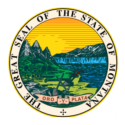Montana was part of seven different territories over its history. Initially, the eastern and western parts of what it now Montana were in different territories.In 1864, Congress passed an enabling act for the Territory of Montana and the residents began working toward statehood. For 25 years, the territory requested statehood, but Congress generally ignored those requests.
Montana was a wild and woolly place, with conflicts among the Native Americans and the settlers coming in from the States. Custer’s Last Stand, the Battle of Little Big Horn, took place in 1876. There was a large Chinese population, and finds of gold, silver, and copper brought miners in from Ireland and from the states. As we’ve seen with other territories, people from different places didn’t always share the same goals.
Large mining companies grew, and there was a lot of rivalry among the major players. Sheep and cattle ranchers came, too, and they had conflicts of their own. Once the railroads came in the 1880s, Montana advertised in Europe to bring in immigrants from Scandinavia. The lively, diverse population led to political conflicts, too.
The political issues were sometimes personal, but they included some larger issues: Democrats and Republicans, supporters of women’s suffrage (voting rights) and opponents, and differing views on alcohol, opium and prostitution.
One man who moved to Montana from New York wrote about the political climate:
Election! It is a fine day and the democrats are working hard. Lots of drunkenness and fighting… I am looking forward to 1884 when I can vote for President.
In fact, Montana was still a territory in 1884, so the young writer didn’t get to vote for President that year.
Montana finally became a state in 1889, after 25 years of trying.
What can Puerto Rico learn from Montana?
In Citizens Without A State, author Howard Hills wrote of Montana, “The Montana story reminds Puerto Rico that the sooner it stops wasting time talking about ‘autonomy’ and independence, and changes the narrative based on self-determination for statehood, the better. Even when statehood is the only democratic solution, petty partisan politics can delay admission by years.”
Montana had mineral deposits which were important to the nation. The transcontinental railroad passed through the territory. Montana was expected to be a Republican state (and unlike so many other territories, it has actually lived up to that) and Republicans in Congress wanted Montana to become a state.
How did Montana manage to spend a quarter of a century working on statehood before their final success? With what historians usually seem to call “turmoil.” Nobody in Montana wanted independence, but there were so many other issues on people’s minds that statehood eluded the territory for many years.
So Puerto Rico can certainly learn that unity works better. But Puerto Rico can also learn that the path to statehood may be, as one Montana historian put it, “meandering,” but statehood is the most common outcome for territories of the United States. It can take a while, but Puerto Rico will gain admission.








No responses yet